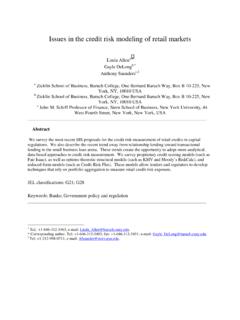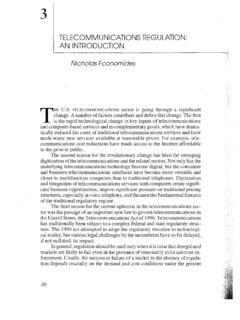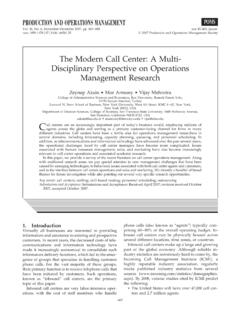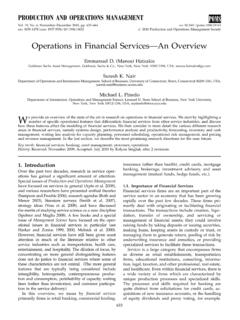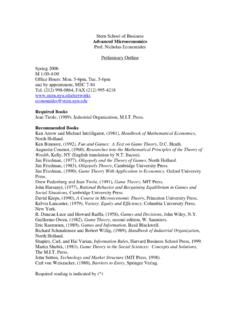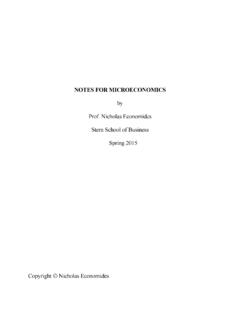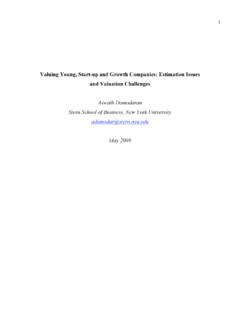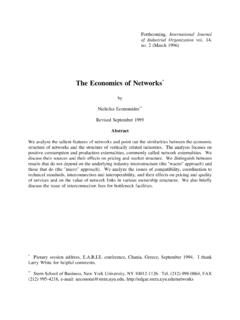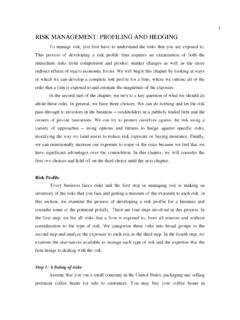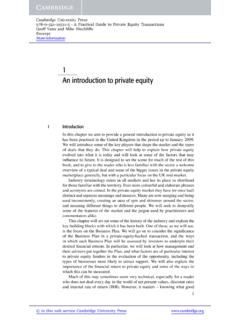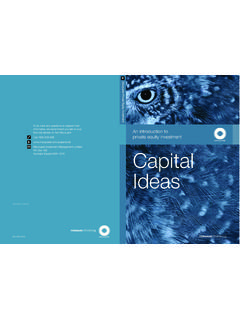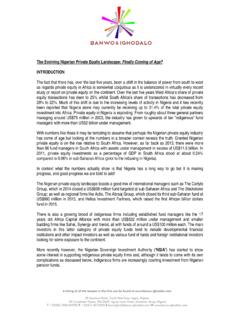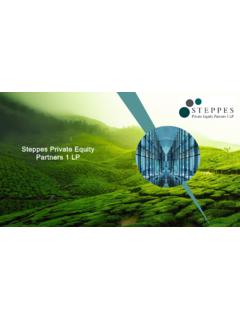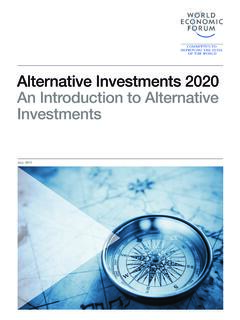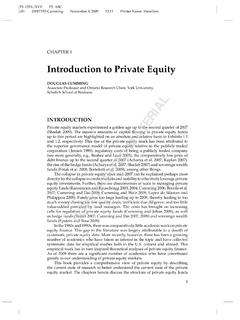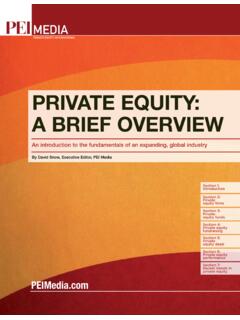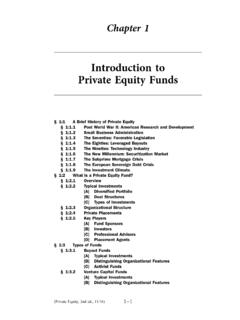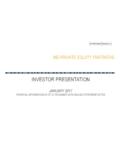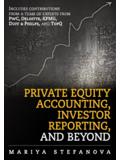Transcription of Private Equity: Beyond the “storytelling” - stern.nyu.edu
1 1! Private equity : Beyond the storytelling !Aswath Damodaran Home page: Twitter: @AswathDamodaran Blog: 2!The Private equity debate: Key questions!1. What is Private equity investing? 2. Who are these Private equity investors? 3. Who do they target? 4. What do they do at these targets? 5. Do they make money? 6. Do they do good or bad? 3!What is Private equity ?!4!To understand Private equity , you have to go back to the !AssetsLiabilitiesAssets in PlaceDebtEquityLenders, both short and long term, get first claim whatever cash flow is generated by the investors get whatever is left over, after meeting the debt AssetsValue of inestments you have already made as a company over your history. Their value is updated to reflect their current cash flow of investments you expect the company to take int the future. This value rests on perceptions of the opportunities you see for the of equity !
2 Private : Owner, Venture Capital, Institutions!Public: Stockholders (individual, institutional)!5!An idea business to IPO!6!A public company !7!A real world !8!The corporate governance and market !Insider(s) 4% Public 96% Mature public 1. Market may be mispricing the firm 2. The company may be operating in a bad business or its business model could be broken. 3. The company may be mismanaged. 9!And there are lots of poor performing companies in the market!10!A road map for value creation!Status Quo ValueIntrinsic value of firm with existing managementOptimal ValueIntrinsic value with "best" management in placeXX1 - Probability (Management Change)Probability (Management Change)Expected value = Status Quo value (1- Prob(chg))+ Optimal Value (Prob(change)Market ValuePricing GapValue Gap11!Provide an entr e for Private equity !Insider(s) Public 96% Mature public Gets key managers to buy in as equity investors.)
3 !The general partners (GP) of the PE firm raise equity capital from limited partner (LP) equity investors and borrow the rest!Insider(s) 15% Private equity : Borrowed 40% Private equity : GP equity 25% Private equity : LP equity 20% Private equity 12!The time line for with risks at each stage!"Public" company acquired with mix of debt & equity and taken privateRun as a Private company, with changes made to asset mix and operationsPrivate equity investors come up with the equity portion of the transactionPrivate equity investors provide "management" and "strategic" input, and receive management fees and residual cash payouts."Fixed" company is taken back public or sold to a public equity investors sell their equity stake in the public market at market Wrong target2. Too high a priceRisksIf business model fails or economy weakens:1. Asset sales disappoint2. Too much debtRisksMarket/Sector weakness leads to poor exit values13!
4 Who are these Private equity investors?!14! Private equity has grown over but remains cyclical!0 100 200 300 400 500 600 1980 1981 1982 1983 1984 1985 1986 1987 1988 1989 1990 1991 1992 1993 1994 1995 1996 1997 1998 1999 2000 2001 2002 2003 2004 2005 2006 2007 2008 2009 2010 2011 US Buyout Deal value: 1980-2011 Strong economy & rising markets!Conglomerate inefficiency & Junk bond markets!Credit bubble & Cheap debt!15!And it is an increasingly global phenomenon!16!With Emerging Market companies leading the !17!Here are the biggest !18!But many of these institutions have individuals behind !19!Who do they target?!20!Who do they target?!The typical target company in a PE buyout is one that is under performing its peer group in profitability and stock price performance, and with relatively small insider holdings.!21!And what are their reasons?!You have to be able to buy the target company at the right price.
5 !22!And are spread around !23!And what do they try to do at these firms?!24!Cashflows from existing assetsCashflows before debt payments, but after taxes and reinvestment to maintain exising assetsExpected Growth during high growth periodGrowth from new investmentsGrowth created by making new investments; function of amount and quality of investmentsEfficiency GrowthGrowth generated by using existing assets betterLength of the high growth periodSince value creating growth requires excess returns, this is a function of- Magnitude of competitive advantages- Sustainability of competitive advantagesStable growth firm, with no or very limited excess returnsCost of capital to apply to discounting cashflowsDetermined by- Operating risk of the company- Default risk of the company- Mix of debt and equity used in financing(1) How well do you manage your existing investments/assets?a. Cost cuttingb.
6 Asset divestituresc. Tax managementd. Working capital management(2) Are you investing optimally fo future growth?a. If ROC < WACC, invest lessb. If ROC > WACC, invest more(3) Is there scope for more efficient utilization of exsting assets?(4) Are you building on your competitive advantages?a. Augment existing advantagesb. Find new barriers to entry(5) Are you using the right amount and kind of debt for your firm?a. Change mix of debt and equityb. Match debt to assetsc. Make your products less discrtionaryd. Reduce fixed costsWith young growth firms, start of the life cycle: Focus on (2)With established growth firms, later in life cycle: Focus on (2, (4) and (5)With mature firms, middle of life cycle: Focus on (1), (3) and (5)With declining firms, end of life cycle: Focus on (1) and (5)25!On the governance they push for changes! Board of directors: The board of directors at target firms is picked by the equity investors in the buyout deal and therefore is more active in overseeing management.)
7 Boards of the targeted firms tend to become smaller and meet more frequently after buyouts. More of the directors are picked for their expertise in the target firm s business Top management: While some of the managers in the target firm are part of the buyout team, there is also a greater push on accountability and compensation: The likelihood of CEO turnover jumps at firms that have been, increasing after the targeting. One study found that two-thirds of CEO of buyout companies were replaced within four years of buyout. CEO compensation decreases in the targeted firms in the years after the activism, with pay tied more closely to performance. 26!On the operating less in invested back into existing ! The firms that are targeted by PE investors tend to be investing less in their businesses than their peer group even before the PE and there is a decline in that reinvestment after the PE.
8 When growth firms are targeted by PE groups, there is no perceptible decrease in R&D and other investments after the buyout. Control firms Target firms, pre-PE Target firms, post PE Cap ex as % of total assets 27!And there is asset redeployment! There is an increase in divestitures, especially in non-core businesses, for firms with business sprawl. There is very little evidence of wanton stripping of assets for cash, , the divestitures are generally not overboard are driven by the need to service debt. At the same time, many targeted firms find new businesses to invest in and change their asset mix. 28!With effects on ! All PE firms In highly levered PE In lightly levered PE Change in EBITDA/Sales ratio PE & Classified by leverage Profit and PE: Changes in EBITDA/Sales at PE firms - Two years prior & after buyout Year: -2 Year: -1 Year +1 Year +2 Target firms come into buyouts with declining profitability in the two years prior but see improvements in the two years after, and more so in highly levered firms.
9 !29!On the financial they do borrow money to finance the !0% 10% 20% 30% 40% 50% 60% 70% 80% 2000 2001 2002 2003 2004 2005 2006 2007 2008 2009 2010 2011 Debt as % of Transaction Value: Buyouts from 2000-2011 0 1 2 3 4 5 6 7 2000 2001 2002 2003 2004 2005 2006 2007 2008 2009 2010 2011 Debt as multiple of EBITDA Debt as multiple of EBITDA at Buyout Companies Subordinated debt Senior debt PE investors use more debt in funding transactions than other public companies.!Default risk increase as debt increases as % of value and cash flows!Existing bondholders/lenders may be adversely affected, if they did not protect themselves.!30!But the PE record on default is only slightly worse than it is for non-PE firms with similar ! % of firms that defaulted during year Default rates: PE versus non-PE firms Non-PE firms PE firms PE firms are less likely to be liquidated (11% vs 16%) & stay in bankruptcy for shorter periods than non-PE firms.
10 !One study found that only of PE firms defaulted between 1980 & 2002. In contrast, the default rate across all publicly traded firms was !31!And on dividend policy, there is little evidence that PE firms strip firms and cash ! Special dividends: While there are some who fear that PE investors pay themselves large dividends right after they take over target firms, special dividends remain rare. A study of 788 Private equity targets, tracked from 1993 to 2009 found only 42 instances of special dividends paid to PE investors. Asset strips: While there are undoubtedly some PE houses that turn target companies into ATMs, selling assets and drawing cash out of them, they are not the norm. 32!Do they make money?!33!When the transaction is !34!Ways for PE to generate profits from the transaction! Management fees: When the PE investor runs the company as a Private business, the company will pay management fees for the services rendered by the PE investor.
